A delicious BIRTHDAY SALUTE…

—
UPDATED 2/15/25: Hey, it’s Cesar Romero’s birthday! The 1966 Batman TV series’ Clown Prince of Crime was born 118 years ago on Feb. 15, 1907. Perfect time to reprint this piece from 2023 — an excerpt from our pal Jim Beard’s essay in Crazy 8 Press’ The Man Who Laughs anthology. Dig it. — Dan.
—
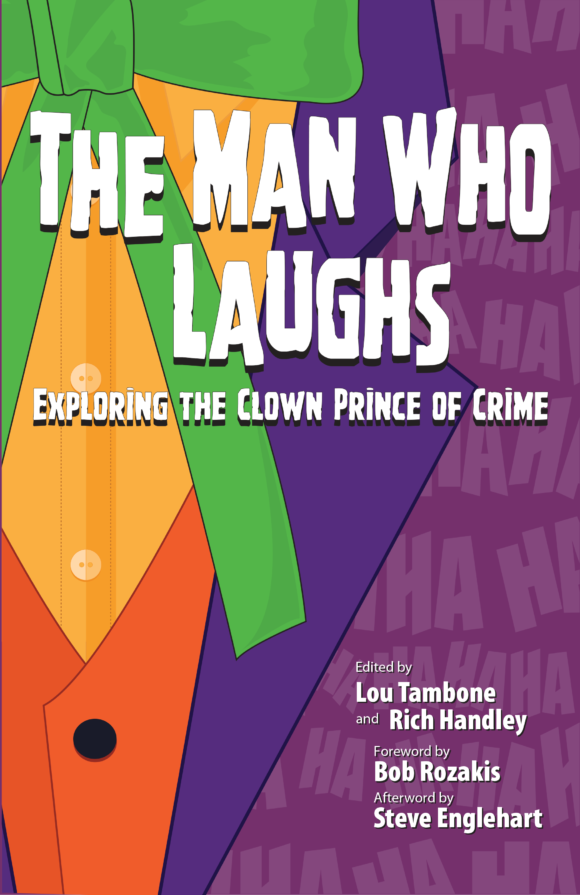
By JIM BEARD
I don’t have to tell you who the Joker is.
You picked up this book; there must be some recognition factor there, a familiarity with the character, an urge to look deeper into it and perhaps learn something or pick up some nuance you didn’t realize before. On that score, I think I can help. Maybe.
In the long history of the Joker, one version has received short shrift, in my opinion. That’s a shame, because it’s the version that offers an aspect that stands unique among nearly all other versions. If you know me at all, even slightly, you know I’m talking about the 1966 Batman television Joker. Yeah, that one. The one played by Cesar Romero.

In essence, Cesar Romero’s Joker is the comic book Joker. Or, at least, he’s the comic book Joker up to 1966. In fact, I’ll state unequivocally Romero’s Joker is the closest version of the character to the source material ever. And I’ll die on that hill.
Not long after his first appearance in 1940’s Batman #1, the murderous, jewelry-loving Joker softened his outlook and curbed his more violent predilections. From the early ’40s on, he focused his energies on larger-than-life schemes to gain riches and best Batman in matches of wit and skill. Oh, he absolutely tried to kill the Caped Crusader many times over, but interestingly enough, he never killed anybody again after those first few forays of his early days.
The comic book Joker throughout the ’40s, ’50s and into the ’60s was most assuredly wild, but he was still just a gaudy crook. The Batman TV series not only picked up on all that, but in fact replicated it down to its brass tacks.
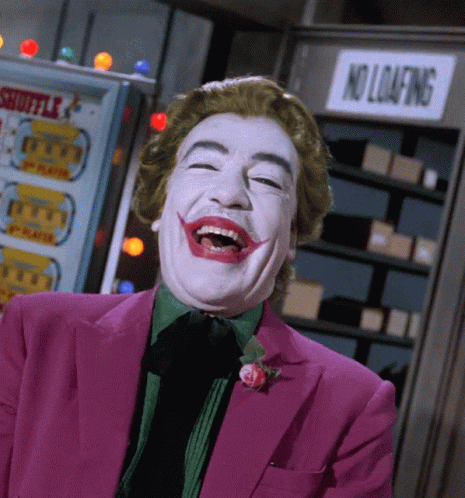
The cathode ray tube Joker is a colorful bad guy who laughs a lot. Like his comic book doppelgänger, he possesses a massive, ponderous ego that cannot suffer fools lightly and, when confronted by his nemesis, wants nothing much more than to show Batman who’s boss in the brains department. His ideas for crime are big, bold, and brassy. The police know it’s him behind them the moment the schemes rear their crazy craniums. Batman thinks of the Joker as a “tricky devil” and a “grinning devil,” and possessed of an “insane conceit.”
That’s an interesting point, by the way: The TV Joker, again like his four-color counterpart, is not nuts. Not really. I mean, no more so than any of the other villains who formed Batman’s early rogues gallery on the tube and on the page. As you most likely know, the actual insanity comes later in the Joker’s history; in 1966, he’s just full of mirth. He sees the humor in nearly everything, even swears “by all that’s funny,” but when the chips are down, the television Joker is deadly serious. And he’s not above rough fisticuffs, either.
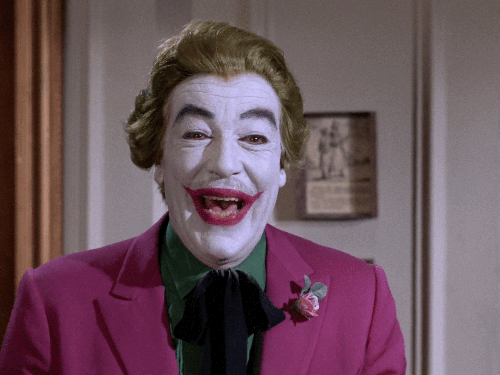
In the show, the Joker’s real name is never revealed, of course, but there is a hint of an earlier life for the Hateful Harlequin. In “The Impractical Joker,” Batman tells Robin, “When he was younger, the Joker was a well-known hypnotist.” This is an added wrinkle on the part of the show; as far as I know, there’s nothing of this nature in the comics pre-1966.
There is, of course, the famous origin story in 1951’s Detective Comics #168, “The Man Behind the Red Hood!” in which readers learned how the unnamed criminal under the hood became the bleached-white, green-haired Joker. Incredibly, Cesar Romero, despite that story never being related on TV, knew the origin of his role and mentioned it during a taped interview he gave while promoting the 1966 Batman feature film. I’d love to know who filled him on that.
The hiring and casting of Romero was inspired, and while the actor himself was famously unaware of exactly why the production team chose him for a role he claimed he’d never done anything remotely like in his career up to that point, I’m guessing it was because of his standing as one of Hollywood’s leading lovers. And that’s where things get very, very interesting in the history of the Joker.
Cesar Romero made his mark in films by almost always being the suave, exotic guy women swooned for. His good looks, charm, bedroom eyes, and touch of accent fed that status, and he made a good life out of it. And then came the Joker, and that same role continued.
You see, one of the most compelling things about the Batman TV series is its introduction of the concept of molls into the Caped Crusader’s universe.
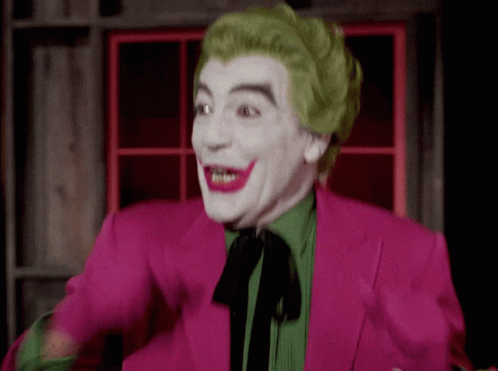
The Joker was right there with his fellow felons on this score, perhaps even more so. And I’d say that was because Cesar Romero lurked beneath the white grease paint and green wig. When you hire a Latin loverboy to play the Clown Prince of Crime, you don’t pass on the pulchritude—and you don’t demand he cover up his trademark mustache. The chicks may dig the car, Caped Crusaders, but they love the ‘stache.
So, what’s our takeaway here? If I had to venture one—and I will, because I’m the essayist, old chum—I’d say it’s this: Cesar Romero was the perfect Clown Prince of Crime for the times. In effect, he’s the Joker we deserved, and the one we needed in the Swingin’ Sixties.
—
You want more? You definitely do. Jim goes on to talk about all of the actresses who played the Joker’s molls, including Donna Loren, Kathy Kersh, Sivi Aberg and many more. The Man Who Laughs, edited by Lou Tambone and Rich Handley, with a foreward by Bob Rozakis and an afterword by Steve Englehart, is due in April from Crazy 8 Press. Click here for more info. The price has not yet been set.
—
MORE
— THE MAN WHO LAUGHS: Dig This INSIDE LOOK at the Upcoming JOKER Anthology. Click here.
— BATMAN ’66: The JOKER’s TOP 13 Devilish Devices. Click here.
—
JIM BEARD has pounded out adventure fiction since he sold a story to DC Comics in 2002. He’s gone on to write official Star Wars and Ghostbusters comics stories and contributed articles and essays to several volumes of comic book history. His prose work includes his own creations, but also licensed properties such as Planet of the Apes, X-Files, Spider-Man, Kolchak the Night Stalker and Captain Action. In addition, Jim provided regular content for Marvel.com, the official Marvel Comics website, for 17 years.
Check out his latest releases: Rising Sun Reruns, about classic Japanese shows on American TV; a Green Hornet novella How Sweet the Sting; his first epic fantasy novel The Nine Nations Book One: The Sliding World; and the most recent Batman ’66 books of essays he’s edited: Zlonk! Zok! Zowie! The Subterranean Blue Grotto Essays on Batman ’66 – Season One, Biff! Bam! Ee-Yow! The Subterranean Blue Grotto Essays on Batman ’66 – Season Two and Oooff! Boff! Splatt! The Subterranean Blue Grotto Guide to Batman ’66 – Season Three.
He’s also published novels about a character very much like G.I. Joe (and Big Jim and Action Jackson): DC Jones – Adventure Command International.
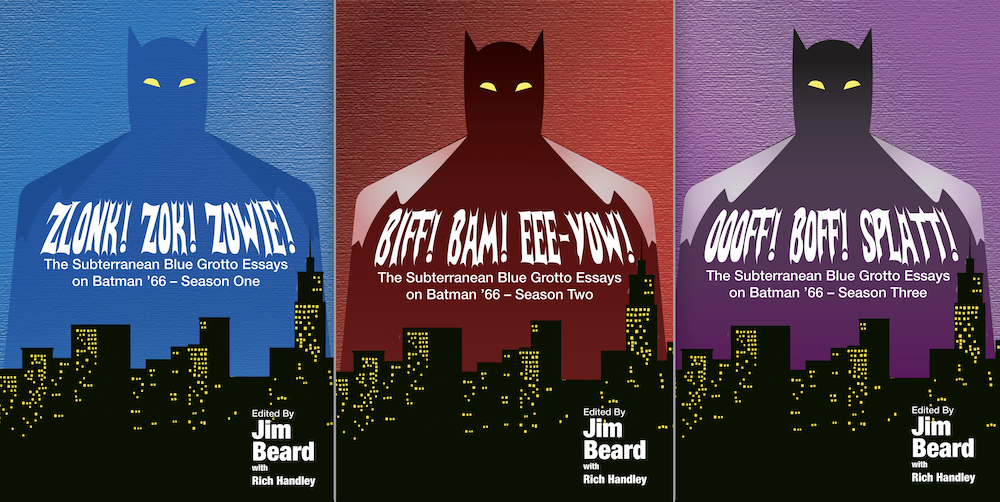

February 15, 2023
Happy birthday to the late Cesar Romero.
February 18, 2023
Didn’t Cesar Romero also play a clown on an episode of the Twilight Zone? I only saw the ending, but I recall him using a “Joker like” laugh.
February 15, 2023
You have to be nuts not to see Romero in both the Nicholson and Hamill versions as well. It really is an iconic and influential interpretation
February 15, 2023
This is “my” Joker. Not sadistic… just a classic bad guy. Is he crazy? Is he acting? Is it makeup or his skin?
Who knows? He’s definitely dangerous, and a menace, but he would never peel off his face and wear it as a mask. Never.
February 15, 2025
Agreed. People tend to forget this Joker could in fact be conventionally dangerous. In the Zodiac Crimes three parter he had no compunction about holding a knife to his own moll’s ( Venus) throat and using her as a human shield to escape. That’s a scene that wouldn’t have been at all out of place in something by O’Neil and Adams.
February 15, 2025
Ah, Venus. That poor deluded girl.
February 15, 2023
A class act who set THE platinum standard for the Clown Prince of Crime!!!
February 15, 2023
AMEN!!!!!!!!!!!!!!!!!!!!!!!!!!!!!!!!!!
February 15, 2025
There’s no getting away from Cesar Romero when discussing The Joker. He’s the original – he captured the essence of The Joker up to that point and every Joker since has been influenced by his portrayal either directly or indirectly (the suit worn by Joaquin Phoenix is very similar to the suit worn by Romero). I’m glad to see he’s getting some recognition for his contribution to the Batman mythos.